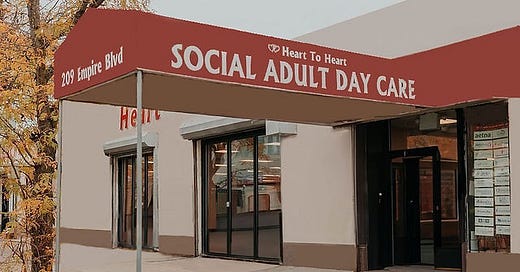The "Swinging Sixties" Club, paid for by Medicaid
The realities of "social adult day care" centers
I recently learned about the many hundreds of “social adult day care,” or SADC centers, funded by Medicaid, which have proliferated throughout New York State. In Brooklyn alone, there are 157 such facilities by my count, with names like “Friendly Connections,” “Happy House Adult Day Care,” “Lucky Social Daycare,” or even “The Club at Swinging Sixties.”
One family member, who works in an office building that also houses an SADC, explained that large Mercedes buses pull up each weekday to drop off well-dressed people who enjoy catered breakfasts and lunches along with a day’s worth of entertainment and socializing “therapies,” alongside more conventional services like physical therapy. As the NY.gov website explains, services include: “nursing, transportation, leisure activities, physical therapy, speech pathology, nutrition assessment, occupational therapy, medical social services, psychosocial assessment, rehabilitation and socialization, nursing evaluation and treatment, coordination of referrals for outpatient health, and dental services.”
This all sounds well and good—there is certainly an argument to be made in favor of community support for the indigent or elderly having access to socialization. But “leisure activities” were never part of what Medicaid specifically promised to offer.
On July 6, the Wall Street Journal ran a long report alerting readers to steep healthcare cuts in Trump’s “big, beautiful bill.” The authors note the alarm among “some hospitals, doctors and patient-advocacy groups” worried that millions will lose vital health insurance and that struggling hospitals may have to “lay off staff or shut down some services.” The authors present this as a self-evident problem.
A separate WSJ report by Joseph Walker and Dominique Mosbergen, on July 1, notes that lawmakers on the right have been touting new work or volunteer requirements for Medicaid beneficiaries. They cite “healthcare experts” and the nonpartisan CBO in asserting that “the requirements, if enacted, would lead to millions of low-income people losing their health insurance or being unable to sign up in the first place.” This, of course, would be part of the point: removing ineligible people from the Medicaid rolls. But Walker and Mosbergen again suggest that this constitutes a self-evident problem.
The loudest voices protesting Medicaid cuts present it as a “lifesaving program”; a July 9th report by National Nurses United notes a study by the National Bureau of Economic Research, which finds that Medicaid expansion “has saved more than 27,000 lives since 2010.” The vision of Medicaid as providing much-needed medical testing and procedures for the indigent does not square with the daily reality witnessed by my family member and attested to on New York State’s government website: daily meals, transportation, and “leisure activities” provided for largely functioning adults consigned to a day care program.
This is just one small example of mission creep: the obvious waste that has found its way into a system that promised vital medical services such as heart surgery. I plan to write more about the bipartisan disillusionment with American healthcare revealed by the “big, beautiful bill”; perhaps more important than limiting the number of Medicaid beneficiaries is understanding where the money goes.





Do you understand the difference between Medicaid and Medicare?
https://www.medicaidlongtermcare.org/benefits/medicaid-coverage-adult-day-care/
This gives more detailed factual information.
You’re welcome.